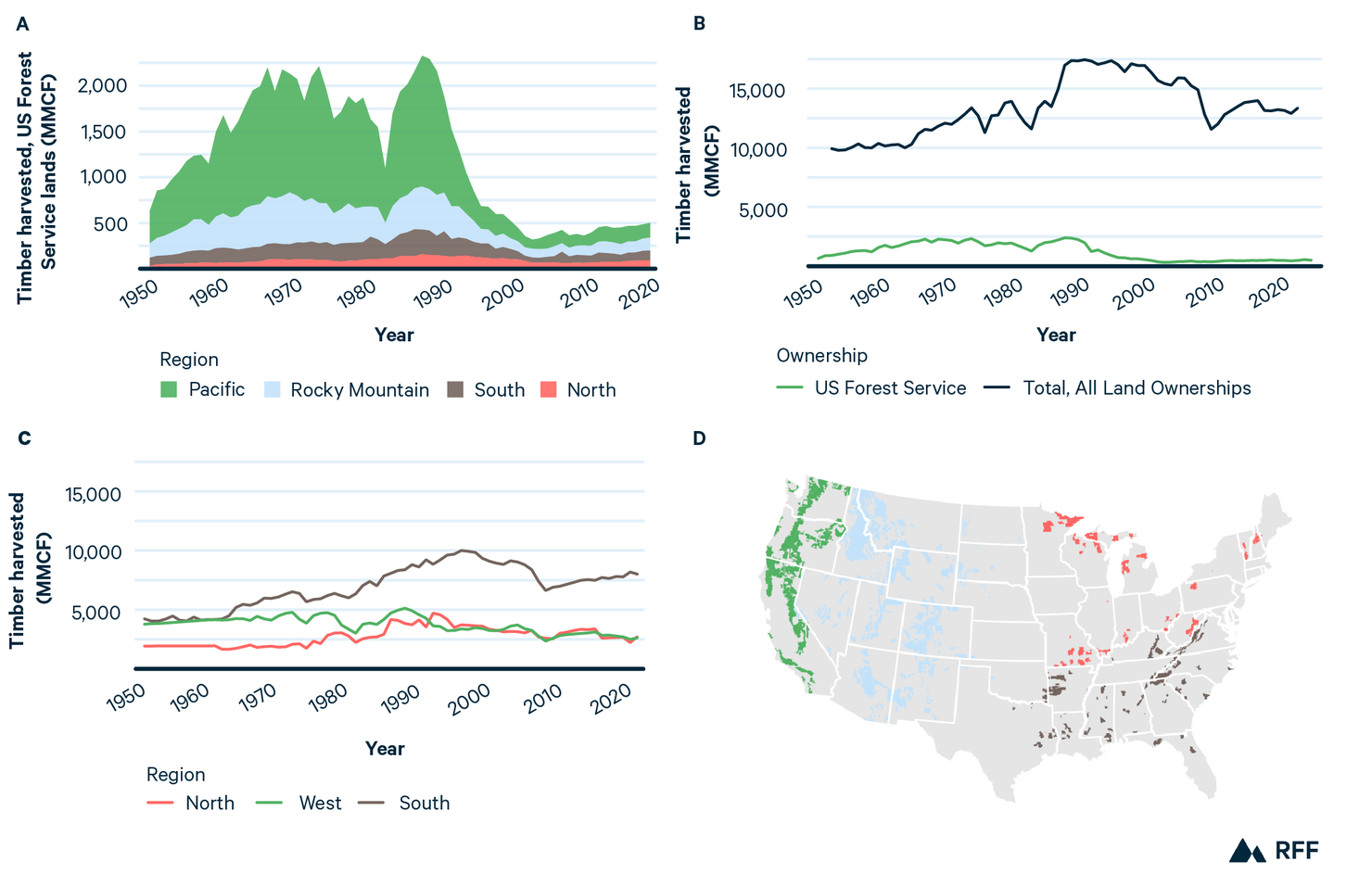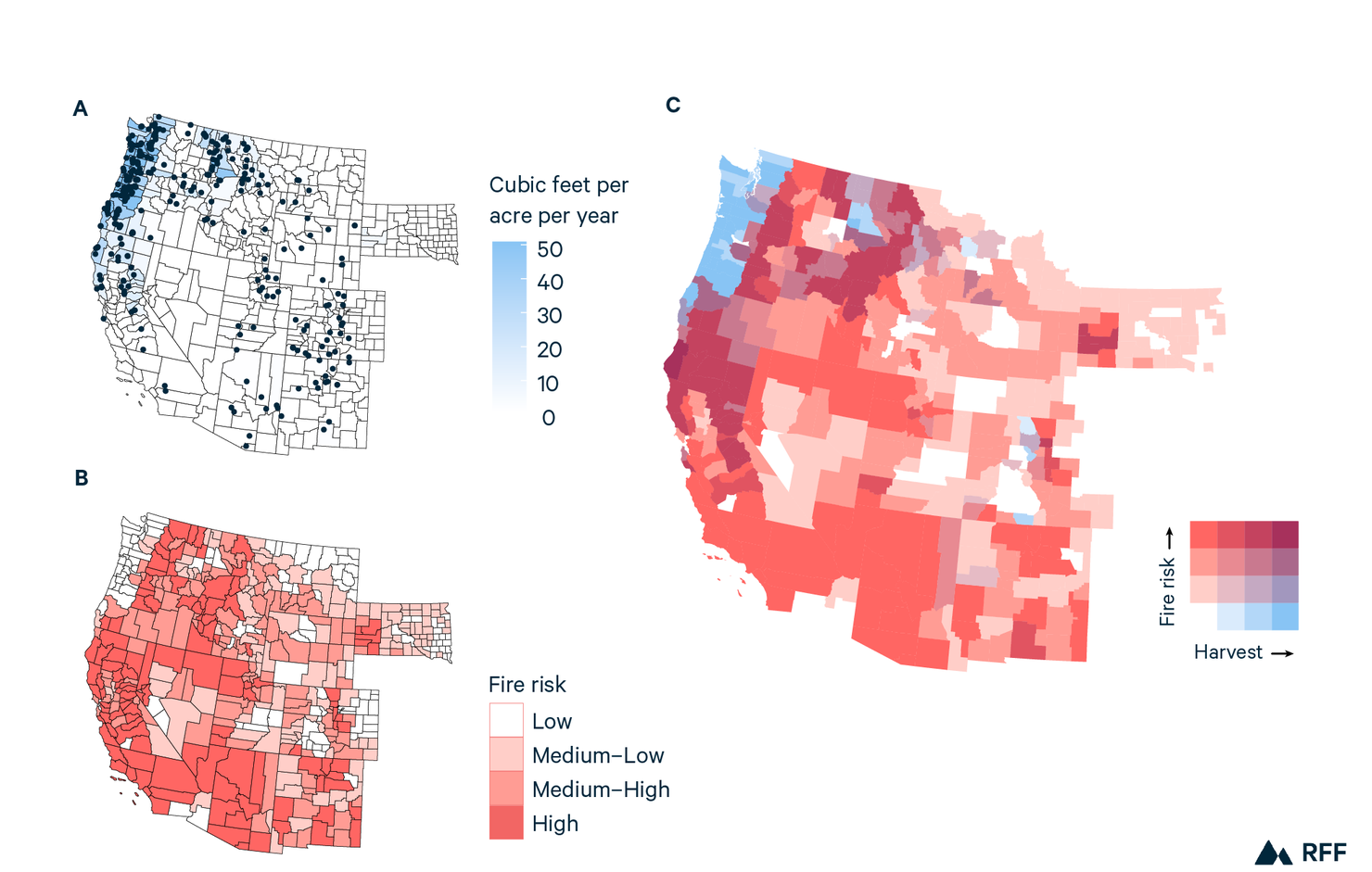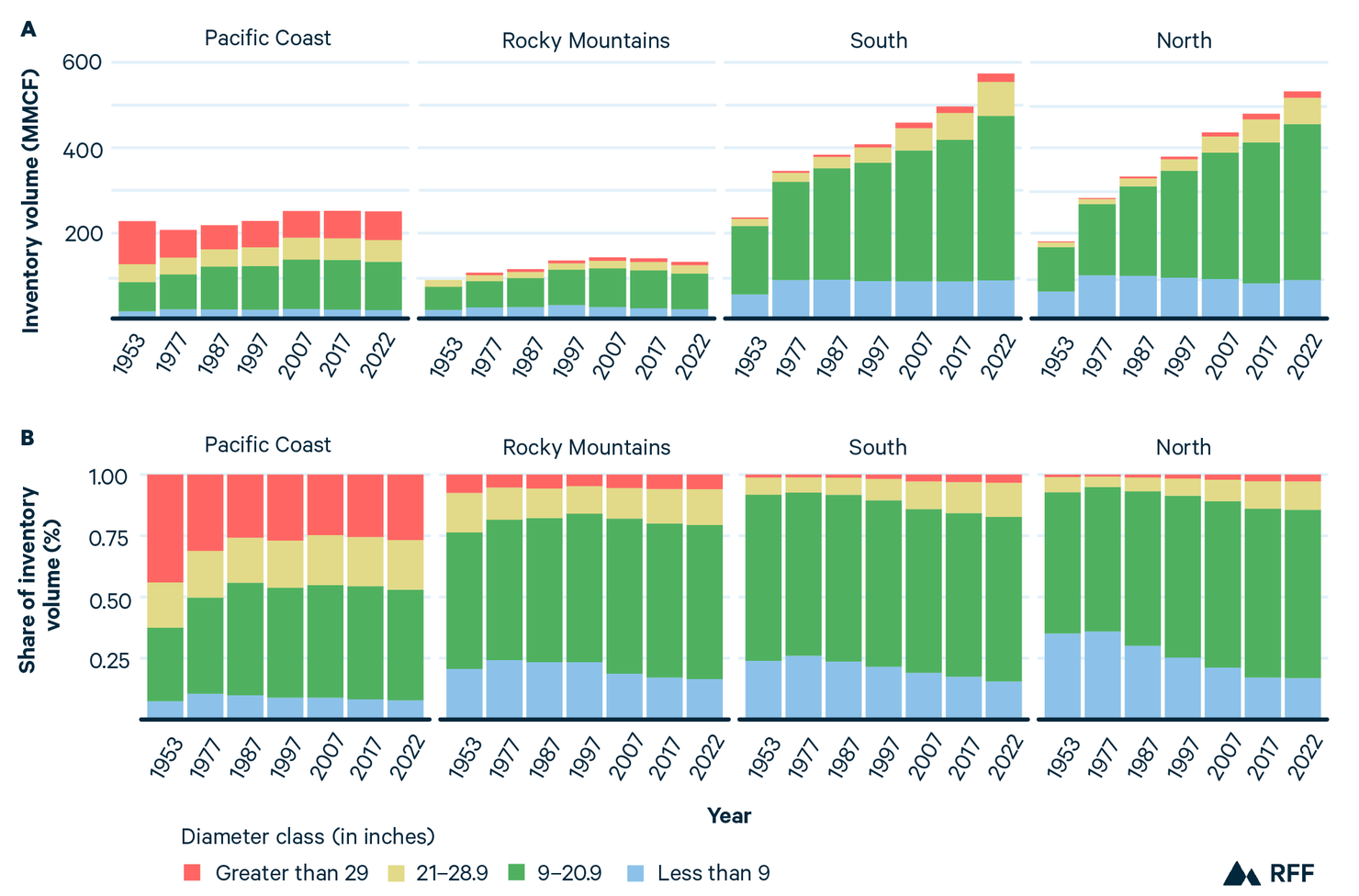Will Increased Timber Harvesting on Federal Lands Reduce Growing Wildfire Hazards?
This report examines the potential impact of a 25 percent increase in federal timber harvests on wildfire risk in the context of President Trump’s March 2025 executive order (EO 14225).
Abstract
On March 1, 2025, President Trump issued an executive order (EO 14225) directing the Secretaries of Agriculture and the Interior to develop plans to increase timber production on federal lands. The order was motivated by two stated priorities: expanding the timber supply and addressing rising wildfire risks. The US Forest Service has responded with a goal of increasing timber offered for sale by 25 percent over the next four to five years. This report puts the Trump administration’s actions into context by reviewing the history of harvest from federal lands and evaluating current forest inventories and treatment needs. It asks: What would be the effect on wildfire risk if federal land management agencies increased harvests by 25 percent? Opportunities for harvests that successfully mitigate risk may be limited by the absence of active timber markets, the availability of a qualified workforce, and the economics of fuel removals. While selective harvesting can play a role in hazard reduction, effects on risk depend on how and where harvests are implemented. Market realities and declining federal capacity to implement nuanced, site-specific forest treatments present real constraints. Moreover, the national significance of expanded federal harvests is limited; federal lands have long accounted for a small share of total US timber production, and most timber now comes from private lands, particularly in the South. Whether agencies can achieve both increased timber supply and meaningful reductions in wildfire risk will depend on how strongly the latter goal is prioritized in the design of timber sales.
1. Introduction
On March 1, 2025, President Trump issued an executive order (EO 14225) directing the secretaries of agriculture and the interior to develop plans to increase timber production on federal lands. EO 14225 frames the directive around two priorities: expanding the timber supply and addressing rising wildfire risks. More specifically, the EO tasks the secretaries with providing guidance regarding tools for facilitating increased timber production and defining new goals for the annual amount of timber to be offered for sale each year over the next four years. A related EO (14223) directs the secretary of commerce to ”initiate an investigation under section 232 of the Trade Expansion Act to determine the effects on the national security of imports of timber, lumber, and their derivative products” and evaluate the “national security risks associated with imports of timber, lumber, and their derivative products.” The EO further directs agencies to expand the scope of categorical exclusions from environmental review and apply emergency consultations under the Endangered Species Act using authorities established by the Healthy Forest Restoration Act and sections of the Infrastructure Investment and Jobs Act focused on remediating wildfire hazards.
Subsequent memos by Secretary of Agriculture Brooke Rollins and Acting Associate Chief of the US Forest Service (USFS) Chris French, respectively, declared an emergency situation on 66 million acres of USFS land and announced a goal of increasing timber offered for sale by USFS by 25 percent over the next four to five years. Under section 40807 of the Infrastructure Investment and Jobs Act, the emergency declaration opens the door to expedited environmental review for activities that mitigate fire risk. This report puts the Trump administration’s actions into context by providing data on the history of harvest from federal lands and on current forest inventories and treatment needs. It asks: If federal land management agencies increase harvest by 25 percent, how will this affect wildfire risk? We argue that increasing federal harvests could be consistent with wildfire hazard reduction, but whether they are depends on how they are implemented. Opportunities for harvests that successfully mitigate risk may be limited by the presence of active timber markets and the economics of fuel removals. The degree to which agencies are successful in both increasing timber supply and reducing fire hazard will ultimately depend on the relative emphasis placed on the latter goal.
2. A Brief History of Timber Harvesting on US Federal Lands
Figure 1 illustrates the history of US timber production over the past 70 years. Panel A shows timber harvests on USFS lands since 1970. Federal harvests, dominated by harvests in the Pacific region (California, Oregon, and Washington), increased through the 1950s and 1960s. After a brief decline caused by the economic recessions of the early 1980s, harvest on USFS lands peaked in 1987, when nearly 2.4 billion cubic feet of timber was harvested (panel A). Between 1960 and 1990, on average, nearly 2 billion cubic feet was harvested each year.
Figure 1. Timber Harvest Over Time on US Forest Service Lands and on All US Forestlands

Sources: Data in panels A and B are from USFS Cut and Sold Reports. Interpolated data in panels B (all lands) and C are based on USFS RPA Assessments.
Note: The harvest on USFS lands is shown in panels A (by region) and B (total); the harvest on all US forestlands is shown in panels B (total) and C (by region). Regions in panel A are based on aggregations of USFS regions depicted in panel D. In panel C, the West region combines the Pacific and Rocky Mountain regions. MMCF = million cubic feet.
Beginning in the late 1980s, timber production from US federal lands began to fall within all regions as a result of new constraints on federal harvesting imposed by environmental regulations such as the Endangered Species Act (ESA) and the National Forest Management Act (NFMA), and possibly also because of rising softwood imports from Canada (CRS 2001). Federal harvests in the Pacific Northwest, where the decline was signified by the ESA listing of the northern spotted owl, fell especially sharply, from over 1.1 billion cubic feet annually in the 1980s to about 160 million cubic feet annually in the 2010s.
Panels B and C show, respectively, total federal timber harvests against total harvests from all lands and harvests from all lands by region. Because of the relatively small contribution of federally managed forests to national timber harvests, the dramatic decline in federal production did not result in similar shocks to the overall domestic timber supply—though supply shocks were consequential for softwood lumber supply and for western regions. Supply shocks had transitory price and welfare impacts as timber production and wood products infrastructure shifted to the southeastern United States and imports from Canada expanded (Wear and Murray 2004). Total timber production has remained at roughly 75 percent of its peak level in 1990 (panel B), with a majority of timber production shifting to the South (panel C). Some of this decline can likely be attributed to substantial declines in per capita consumption over this period.
However, federal harvests have remained low. Since reaching a 50-year low of 325 million cubic feet harvested in 2003, harvest has increased steadily. But over the past 10 years, harvest has nevertheless averaged just 485 million cubic feet, a decline of 75 percent relative to the average annual level between 1960 and 1990.
Viewed in the context of historical timber production on USFS lands, increasing timber offered for sale by 25 percent would represent a modest increase in timber production; even after increasing the average cut over the past 10 years by 25 percent, timber production would remain at approximately 31 percent of average harvests between 1960 and 1990. Nevertheless, such an increase would be significant relative to the volume of timber recently offered for sale. Moreover, the proposed increase must be considered not just within its historical context but also relative to the degree to which increasing the federal harvest could serve the goal of reducing wildfire hazard on the landscape.
3. Could Increasing Federal Harvests Help Address Growing Wildfire Risk?
It is widely understood that in some parts of the United States, most notably the arid West, wildfire risk has grown in part as a result of the legacy of wildfire exclusion over the past 100-plus years (e.g., Parks et al. 2015; Steel et al. 2015). Where fire once periodically removed fine understory fuels and helped maintain a heterogeneous landscape that served to interrupt fire spread, forests have become homogeneous and dense with vegetation that fuels higher severity fires (Stephens et al. 2013). The primary management tools to moderate fire severity and spread are reintroducing frequent fire and/or mechanically removing some forest biomass.
Active forest management to mitigate growing wildfire hazard has strong scientific support. Agee and Skinner (2005), in a widely cited source on fuel treatment design, argue that fuel treatments should have three objectives: to reduce surface fuels, ladder fuels (mid-height fuels capable of carrying fire into the forest canopy), and crown density. While they emphasize that thinning should be done selectively to maintain the largest trees and preserve age class variation among trees, thinning to reduce crown density can be helpful in reducing crown fire spread. A recent meta-analysis of empirical scientific studies of the effect of fuel treatments on fire severity confirms that thinning treatments are effective in reducing fire severity, and especially so when they are used in combination with burning to remove surface fuels. However, this does not necessarily imply that removals will decrease fire risk. For example, some studies have found that salvage logging can increase surface fuel loads and result in increased fire hazard in the absence of subsequent fuel reduction treatments (e.g., Donato et al. 2006; Thompson et al. 2007). Studies have also found that the young, even-staged stands that can regrow after intensive harvests may be more vulnerable to intense fires (Bradley et al. 2016; Zald and Dunn 2018).
Whether increased harvests are useful for fire hazard reduction goals varies by location and depends on how removals are implemented. Ideally, harvests are implemented consistently with scientific guidelines yet raise enough revenue to cover the costs of treatments and expand the treatable area given a fixed appropriation. Whether this is possible in a particular area depends on both the correspondence of fuel treatment needs with active timber markets and the economic viability of beneficial removals.
In the near term, willing buyers of federal timber are likely limited to areas where timber markets are active. Furthermore, the effects on wildfire risk mitigation depend on the correspondence of these market areas with fuel treatment needs. A Resources for the Future (RFF) analysis of fuel treatment utilization strategies finds that the correspondence between active timber markets and wildfire risk is largely limited to the northern Rockies, the eastern slope of the Cascades, and the northern Sierra-Klamath regions (Figure 2). About one-third of USFS priority landscapes for fuel treatment are found in these regions. While over the longer term, productive capacity might expand to meet anticipated federal supplies, investment is unlikely without supply certainty. Furthermore, a structural scarcity of labor, especially in the logging sector has recently been seen as a constraint to expansion (He et al. 2024).
Figure 2. The Intersection of Fire Risk and Timber Production within the Western United States

Sources: Panel A: Timber production from USFS FIA Evalidator, annual harvest removals, accessed June 17, 2025; mill locations from personal communication, US TPO program. Panel B: FEMA Fire Risk Index.
Note: Panel A shows timber production as thousand cubic feet/acre/year and locations of primary processing mills. Output data are top coded at 50 cf/acre/year. Each dot represents a primary wood-processing mill, defined as sawmills, pulp and paper facilities, plywood and veneer mills, and composite board mills. Mill locations for South Dakota are not available. Panel B illustrates the fire-risk quartiles for the western states. Panel C is a bivariate map of intersection of timber market strength and fire risk (timber output from panel A is summarized using county quartiles).
Harvests that mitigate wildfire hazard are also limited to places where timber sales can be constructed that are both economically viable and beneficial. A 2024 RFF analysis shows that in the northern Rockies region, sales including only the smallest-diameter material (trees smaller than 8 inches in diameter) are rarely economically viable because of the relatively low values placed on this material (Wear, Wibbenmeyer, and Joiner 2024). This is likely to be true in other regions as well. Similar studies in the Sierras also find that small-diameter material is rarely marketable and that sales with additional sawtimber harvest could be merchantable (Cabiyo et al. 2021; Porter and Longcor 2020; Swezy et al. 2021). Absent a direct subsidy for the fire mitigation benefits of a sale, including some level of more valuable timber provides the only practical means to improve economic viability. Increasing the quantity of potentially merchantable timber offered for sale necessarily requires adding some larger-diameter trees to sale offerings.
Removal of some larger-diameter trees could be consistent with thinning for effective fuel reductions, though. Figure 3 shows the total inventories of growing stock timber, across all ownerships, by region and diameter class (panel A) and the share of total inventories in each region by diameter class (panel B). Several trends stand out. First, from 1953 to 1987, the total volume in large-diameter (>29 inch) trees within the Pacific Coast region, and the share of inventory volume in large-diameter trees, declined substantially. Second, inventories in the South and North have increased dramatically since 1953. This reflects the intensive management of a large area of forests in the South and increases in forestland over this period. Finally, in the Pacific Coast and Rocky Mountain regions, timber volume in trees smaller than 21 inches increased steadily over the latter half of the twentieth century. In the Pacific Coast region, the share of total volume in small- to moderate-diameter trees also increased from the 1950s through the 1980s, as stocks of the largest trees declined.
USFS fuel reduction efforts have traditionally targeted trees under 12 inches in diameter, while selectively removing trees up to approximately 21 inches in diameter (the specific threshold varies by region). The increase in timber volume in smaller-diameter trees, visible in forest inventory data, is consistent with the widely understood shift in forest structure resulting from fire suppression, which has allowed smaller-diameter trees to accumulate, resulting in increased hazard. These data, along with USFS guidelines and available science regarding fuel treatment best practices, suggest that removal of moderate-diameter timber, up to about 21 inches in diameter, may be consistent with hazard reduction and forest restoration goals.
Figure 3. Forest Biomass Inventories for Timberland Across All Ownerships, by Region and Diameter Classes

Source: USFS Forest Inventory Analysis Program.
Note: Bars span uneven time periods. Regions are as in panel D of Figure 1. MMCF = million cubic feet.
Nevertheless, this does not imply that the goals laid out in the March 1 EO—increasing federal harvests and reducing fire hazard—are synonymous. The degree to which these goals are achieved simultaneously may depend on the relative importance placed on reducing fire hazard as the order to increase federal harvests is implemented, as well as on how timber sales and subsequent management are carried out.
4. Priorities, Trade-offs, and Constraints in Addressing Hazard Through Harvesting
The implementation of EO 14225 represents a new chapter in a long public dialogue regarding public land management. The need to address public demands beyond timber production gave rise to the Multiple-Use Sustained-Yield Act in 1960. Public concerns about the intensive harvesting of the 1970s led directly to the National Forest Management Act of 1976, which, along with the ESA, brought about substantial harvest reductions by the 1990s. Concerns that regulations and environmental review impede active management of federal forests resulted in the Healthy Forest Restoration Act in 2003, section 40807 of the Infrastructure Investment and Jobs Act of 2021, and the Fix Our Forests bill as it is currently written. The EO extends initiatives that began in the George W. Bush administration to streamline the review of management activities but includes an additional focus on expanding timber production.
We argued in Section 2 that increasing the federal “cut” could be, but is not necessarily, consistent with hazard mitigation. Not all harvests yield hazard mitigation benefits. Moreover, timber sales are restricted to areas with active markets, not all of which are coincident with high fire hazard. Last, harvest strategies most consistent with hazard reduction—low-intensity forest thinning spread over a broad area—may not provide the most expeditious means of increasing harvest volumes. The extent to which EO 14225 achieves its stated goals may depend on the relative priority given to increasing timber production versus reducing wildfire risk. In general, the metrics used to assess progress tend to shape where agencies focus their efforts. While timber outputs—such as volume sold or area harvested—are easily measured, the benefits of wildfire risk reduction are more difficult to evaluate.
Even where priorities align, the impacts of EO 14225 will hinge on agencies’ capacity to implement effective, site-specific treatments. Designing interventions that both reduce hazard and produce merchantable timber requires technical silvicultural knowledge and familiarity with local forest conditions. Yet recent federal workforce reductions have likely accelerated the long-term downward trend in employees specializing in planning, forest management, and contract administration. For example, between 1998 and 2024, the number of professional foresters employed by the USFS declined by about 58 percent. We use employment records across all federal agencies in the FedScope Human Capital Data Cubes for the years 1998 and 2024 to count the number of employees in the professional forester occupation series (0460). In 1998, about 3,305 employees, or about 8 percent of USFS employment, were foresters. In 2024, 1,401 were listed as foresters (about 4 percent). In 1998, 84 percent of all federal foresters were employed by the USFS; in 2024, this declined to 74 percent. An effective program will require greater rather than less on-the-ground forest management expertise.
More broadly, an overarching question is whether timber management activities prescribed by EO 14425 can materially change the structure of fire-dependent forests in the West in ways that alter hazards to communities while averting damage to other resource values. The order directs federal agencies to consider a range of tools and authorities that could be used to achieve increases in the federal cut, including various steps to streamline the environmental review process under the National Environmental Policy Act and invoking emergency consultation provisions under the ESA. These proposed reforms have drawn comparisons to past efforts—such as the 1995 Salvage Logging Rider under President Clinton and the 2003 Healthy Forests Initiative under President George W. Bush—which were promoted as wildfire risk reduction measures but were criticized for prioritizing timber production over ecological integrity. However, management activities on national forests still must comply with standards defined by national forest plans as guided by the National Forest Management Act, which are subject to full environmental impact review.
Therefore, the ultimate impact of regulatory reform on resource conditions will depend on environmental review at both national forest and project levels.
Another overarching question is whether federal timber harvesting could lead to an overall expansion in timber supply. In regional markets in the arid West, where a substantial share of harvests comes from federal lands, the impact could be substantial. But at the national level, supply impacts would be minimal. Harvesting on USFS lands represents only 4 percent of national harvests This is based on average annual USFS harvests since 2015 (491 million cubic feet (MMCF)) and US overall average annual harvests over the same period (13,349 MMCF). , and timber production and industry infrastructure have shifted predominantly to the private sector and to regions beyond the arid West. Private timber producers have a strong comparative advantage in these markets, and growth in federal timber production is unlikely to restructure markets and investment substantially.
If federal land management agencies expand timber production, what will be the effect on wildfire risk? While hazard reduction and timber production can align under certain conditions, the relationship is context dependent, and the degree to which hazard is reduced in the course of increasing federal timber production will likely depend on the priority placed on this objective. Market realities and declining federal capacity to implement nuanced, site-specific forest treatments present real constraints. Additionally, the national significance of expanded federal harvests may be limited: Most timber now comes from private lands, particularly in the South, and federal lands account for a small and declining share of total US timber production. The success of EO 14225 in reducing fire risk will ultimately hinge not on how much timber is offered for sale, but on whether sales are designed effectively to accomplish risk reduction objectives.





